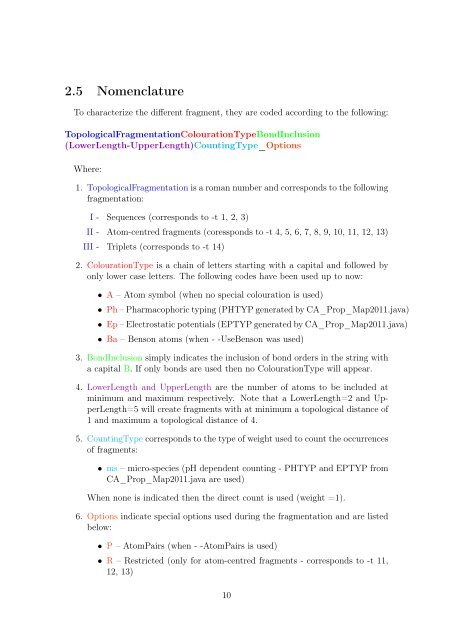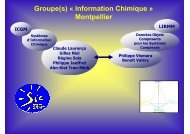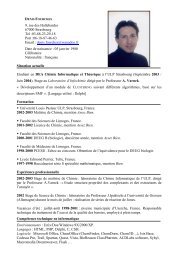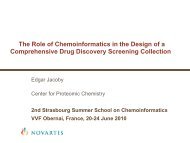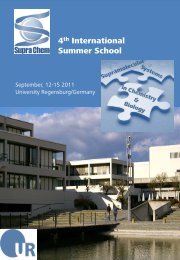ISIDA Fragmentor2011 - User Manual - Laboratoire d'Infochimie
ISIDA Fragmentor2011 - User Manual - Laboratoire d'Infochimie
ISIDA Fragmentor2011 - User Manual - Laboratoire d'Infochimie
Create successful ePaper yourself
Turn your PDF publications into a flip-book with our unique Google optimized e-Paper software.
2.5 Nomenclature<br />
To characterize the different fragment, they are coded according to the following:<br />
TopologicalFragmentationColourationTypeBondInclusion<br />
(LowerLength-UpperLength)CountingType_Options<br />
Where:<br />
1. TopologicalFragmentation is a roman number and corresponds to the following<br />
fragmentation:<br />
I - Sequences (corresponds to -t 1, 2, 3)<br />
II - Atom-centred fragments (coressponds to -t 4, 5, 6, 7, 8, 9, 10, 11, 12, 13)<br />
III - Triplets (corresponds to -t 14)<br />
2. ColourationType is a chain of letters starting with a capital and followed by<br />
only lower case letters. The following codes have been used up to now:<br />
• A – Atom symbol (when no special colouration is used)<br />
• Ph – Pharmacophoric typing (PHTYP generated by CA_Prop_Map2011.java)<br />
• Ep – Electrostatic potentials (EPTYP generated by CA_Prop_Map2011.java)<br />
• Ba – Benson atoms (when - -UseBenson was used)<br />
3. BondInclusion simply indicates the inclusion of bond orders in the string with<br />
a capital B. If only bonds are used then no ColourationType will appear.<br />
4. LowerLength and UpperLength are the number of atoms to be included at<br />
minimum and maximum respectively. Note that a LowerLength=2 and UpperLength=5<br />
will create fragments with at minimum a topological distance of<br />
1 and maximum a topological distance of 4.<br />
5. CountingType corresponds to the type of weight used to count the occurrences<br />
of fragments:<br />
• ms – micro-species (pH dependent counting - PHTYP and EPTYP from<br />
CA_Prop_Map2011.java are used)<br />
When none is indicated then the direct count is used (weight =1).<br />
6. Options indicate special options used during the fragmentation and are listed<br />
below:<br />
• P – AtomPairs (when - -AtomPairs is used)<br />
• R – Restricted (only for atom-centred fragments - corresponds to -t 11,<br />
12, 13)<br />
10


